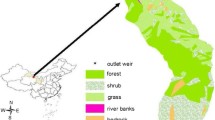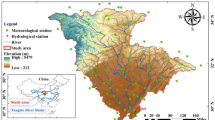Abstract
The temporal resolution of observed data is a critical element in determining the parameters, prediction performance, and applicability of hydrological models. In this study, runoff simulations were performed at different temporal resolutions using the Xinanjiang model to evaluate the influence of temporal resolution on the model parameters and performance. Based on the sensitivity analysis of the model parameters, the posterior distribution of the sensitive parameters was derived using the Bayesian method and Differential Evolution Adaptive Metropolis (DREAM) algorithm at different temporal resolutions. The transformation functions of the model parameters were put forward to transform the parameters according to the regulatory between the parameters and time-steps on the basis of the parameters posterior distribution. The model performance and uncertainty for runoff simulation were compared and discussed at each temporal resolution. The results show that (1) the parameters related with the process of the water balance and runoff routing are identified as sensitive to the temporal resolutions, and there exist linear or power function relationships between parameter values at different temporal resolutions; and (2) the quantitative relationship equations have been verified to have good capacity for model simulation when the model parameters are transformed from other temporal resolution.







Similar content being viewed by others
References
Bastola S, Murphy C (2013) Sensitivity of the performance of a conceptual rainfall–runoff model to the temporal sampling of calibration data. Hydrol Res 44(3):484–494
Campolongo F, Cariboni J, Saltelli A (2007) An effective screening design for sensitivity analysis of large models. Environ Model Softw 22(10):1509–1518
Demaria EM, Nijssen B, Wagener T (2007) Monte carlo sensitivity analysis of land surface parameters using the variable infiltration capacity model. J Geophys Res 112(D11):71–81
Duan QY, Sorooshian S, Gupta VK (1992) Effective and efficient global optimization for conceptual rainfall-runoff models. Water Resour Res 28(4):1015–1031
Engeland K, Gottschalk L (2002) Bayesian estimation of parameters in a regional hydrological model. Hydrol Earth Syst Sci 6(5):883–898
Ficchì A, Perrin C, Andréassian V (2016) Impact of temporal resolution of inputs on hydrological model performance: An analysis based on 2400 flood events. J Hydrol 538:454–470
Finnerty BD, Smith MB, Seo DJ, Koren V, Moglen GE (1997) Space-time scale sensitivity of the Sacramento model to radar-gage precipitation inputs. J Hydrol 203(1):21–38
Garambois PA, Roux H, Larnier K, Castaings W (2013) Characterization of physically based hydrologic model behaviour with temporal sensitivity analysis for flash floods in mediterranean catchments. Hydrol Earth Syst Sci 17:2305–2322
Gelman A, Rubin DB (1992) Inference from iterative simulation using multiple sequences. Stat Sci 4:457–472
Hao F, Sun M, Geng X, Huang W, Ouyang W (2015) Coupling the xinanjiang model with geomorphologic instantaneous unit hydrograph for flood forecasting in northeast china. Int Soil Water Conserv Res 3(1):66–76
Hu CH, Guo SL, Xiong LH, Peng DZ (2005) A modified Xinanjiang model and its application in northern China. Nord Hydrol 36(2):175–192
Kavetski D, Fenicia F, Clark MP (2011) Impact of temporal data resolution on parameter inference and model identification in conceptual hydrological modeling: Insights from an experimental catchment. Water Resour Res 47(5):1034–1037
Krajewski WF, Lakshmi V, Georgakakos KP, Jain SC (1991) A monte carlo study of rainfall sampling effect on a distributed catchment model. Water Resour Res 27(1):119–128
Li Z, Xin P, Tang J (2011) Study of the xinanjiang model parameter calibration. J Hydrol Eng 18(11):1513–1521
Littlewood IG, Croke BF (2008) Data time-step dependency of conceptual rainfall-streamflow model parameters: an empirical study with implications for regionalisation. Hydrolog Sci J 53(4):685–695
Lu M, Li X (2014) Time scale dependent sensitivities of the xinanjiang model parameters. Hydrol. Res Lett 8:51–56
Morris MD (1991) Factorial sampling plans for preliminary computational experiments. Technometrics 33(2):161–174
Ostrowski M, Wolf U (1984) Effects of temporal decomposition on parameter estimation for hydrological models. Hydrol Wasserbewirts 2:37–40
Reynolds JE, Halldin S, Xu CY, Seibert J, Kauffeldt A (2017) Sub-daily runoff predictions using parameters calibrated based on data with a daily temporal resolution. J Hydrol 550:399–411
Schwanenberg D, Fan FM, Naumann S (2015) Short-term reservoir optimization for flood mitigation under meteorological and hydrological forecast uncertainty. Water Resour Manag 29(5):1635–1651
Tang Q, He XB, Bao YH, Zhang XB, Guo F, Zhu HW (2013) Determining the relative contributions of climate change and multiple human activities to variations of sediment regime in the Minjiang River, China. Hydrol Process 27(25):3547–3559
Vrugt JA, Diks CGH, Hyman JM, Higdon D (2009) Accelerating markov chain monte carlo simulation by differential evolution with self-adaptive randomized subspace sampling. Int J Nonlinear Sci 10(3):273–290
Wang Y, He B, Takase K (2009) Effects of temporal resolution on hydrological model parameters and its impact on prediction of river discharge. Hydrolog Sci J:886–898
Wang YC, Yu PS, Yang TC (2010) Comparison of genetic algorithms and shuffled complex evolution approach for calibrating distributed rainfall–runoff model. Hydrol Process 24(8):1015–1026
Xiong LH, Wan M, Wei XJ, O'Connor KM (2009) Indices for assessing the prediction bounds of hydrological models and application by generalised likelihood uncertainty estimation. Hydrolog Sci J 54(5):852–871
Xu CY (2003) Testing the transferability of regression equations derived from small sub-catchments to large area in central Sweden. Hydrol Earth Syst Sci 7(3):317–324
Yao C, Li ZJ, Bao HJ, ZB Y (2009) Application of a developed Grid-Xinanjiang model to Chinese watersheds for flood forecasting purpose. J Hydrol Eng 14(9):923–934
Zhao RJ (1992) The Xinanjiang model applied in China. J Hydrol 135(1):371–381
Acknowledgements
This study was supported by the National Natural Science Fund of China (51190094; 51339004; 51279138) and the Fundamental Research Funds for Central Universities (No.2015206020201).
Author information
Authors and Affiliations
Corresponding authors
Ethics declarations
Conflict of interest statement
The authors declare that they have no conflicts of interest.
Rights and permissions
About this article
Cite this article
Jie, MX., Chen, H., Xu, CY. et al. Transferability of Conceptual Hydrological Models Across Temporal Resolutions: Approach and Application. Water Resour Manage 32, 1367–1381 (2018). https://doi.org/10.1007/s11269-017-1874-4
Received:
Accepted:
Published:
Issue Date:
DOI: https://doi.org/10.1007/s11269-017-1874-4




